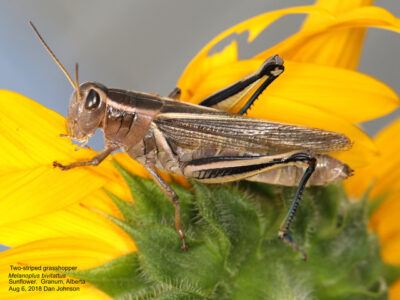Grasshopper forecast grim for next season if conditions hold steady
By Tim Kalinowski on August 4, 2021.
 A two-striped grasshopper perches on a sunflower near Granum during a past growing season. Grasshopper expert Dan Johnson says the grasshopper outbreak could be even worse next season if conditions are again hot and dry. Photo by Dan Johnson
A two-striped grasshopper perches on a sunflower near Granum during a past growing season. Grasshopper expert Dan Johnson says the grasshopper outbreak could be even worse next season if conditions are again hot and dry. Photo by Dan JohnsonLETHBRIDGE HERALDtkalinowski@lethbridgeherald.com
This year’s grasshopper outbreak in the Lethbridge area might be here for another year, and may even grow worse, unless weather conditions next year substantially differ from this year, says Dan Johnson, a world-leading grasshopper authority who now teaches at the University of Lethbridge.
“In this case, they were set up for this with two fairly good years down in the south (of Alberta),” explains Johnson on what led to this year’s outbreak. “Because of the heat, they have maximized their potential. They had excellent hatching conditions. They had rapid growth. They went through their stages quickly. They escaped from their disease. They fed rapidly. And now they are moving.”
Johnson says the two main species involved in this year’s outbreak, two-striped grasshoppers and migratory grasshoppers, are infamous in Alberta’s history for being the leading speci in such outbreaks before.
“One of those is large, fat and hungry,” he explains. “It doesn’t fly much. The other one flies well. So we have a bad mix. The ones that hit the edge of town will be the two-stripe grasshopper, which is big and green. It eats everything. It eats grasses. It eats broadleaf. The migratory grasshopper is a little smaller, but it flies farther. It will push itself a little farther into the city if it stays hot.”
Johnson says this year’s drought conditions have led to a boom in the numbers of both species, but have also led to their infiltration into the City of Lethbridge where West Side residents, in particular, have been impacted.
“If they concentrate in roadsides or even in a crop, if that crop stays green and fresh for them to eat they will more or less stay there,” Johnson says. “But if it gets so hot they are running out of food, or if the crop dies down, for example, then they will leave and look for something green.
“Mostly they are single-minded,” he adds.”They just want to feed on leaves and grass, and they will, unfortunately, hammer the gardens hard. Water will slow them down, but there are not a lot of solutions for gardens.”
Johnson says there is not much the City of Lethbridge can do in terms of control when grasshopper numbers reach the levels we are seeing today in the city and elsewhere in the region.
“It’s kind of a surgical game like firefighting,” explains Johnson. “It’s all about finding them and stopping them before they move. Spraying a roadside or two wouldn’t hurt, but wider than that is probably not worth it.”
Johnson says his biggest concern isn’t about controlling those grasshopper numbers this year which are thick in patches but not yet very widespread. It is controlling the much greater numbers which will come next year if weather conditions are as hot and dry as this summer’s were.
“A little bit more concerning is the fact that all around Lethbridge and southern Alberta we have patches of this happening,” he states. “Those patches are fairly small, but they are fairly intense. So if we continue weather like this, and they lay eggs- and they are laying eggs right now; I have seen them. Those eggs will be in the ground. If they get a little bit of rain later, that is even better for the eggs. So I have a feeling next spring around the end of May or beginning of June they will be hatching. Along the edge of town, but also in these other places where there are these patches. Another year of weather like this will allow those patches to sort of join together, and coalesce a bit more.”
Follow @TimKalHerald on Twitter
4-3


